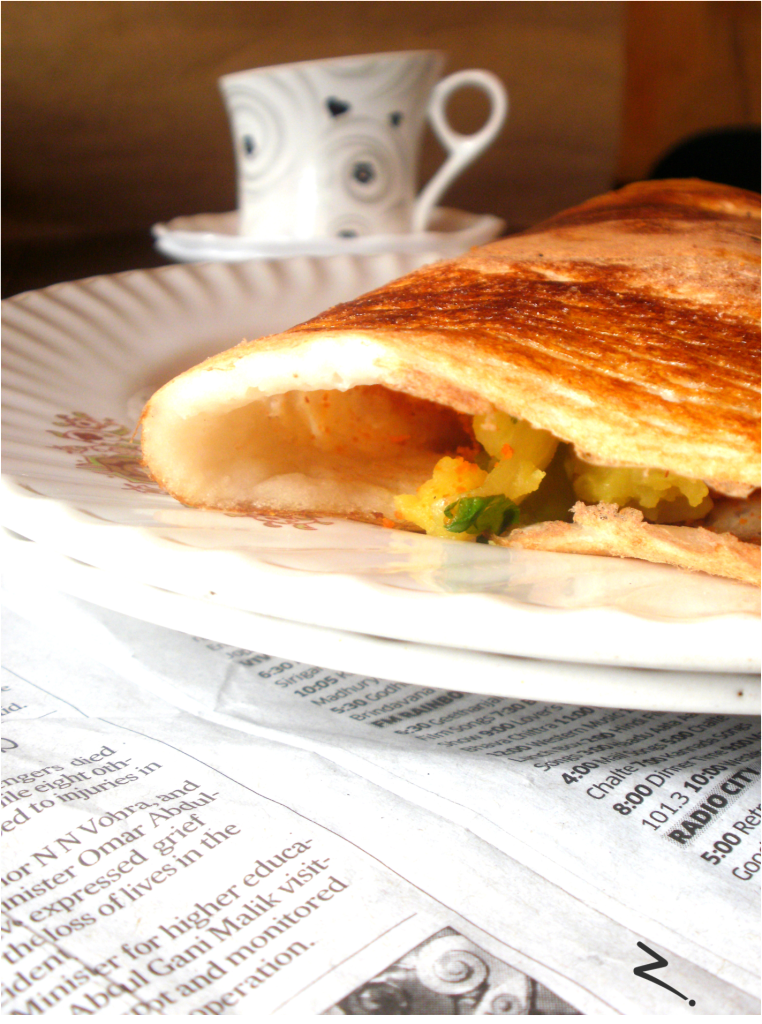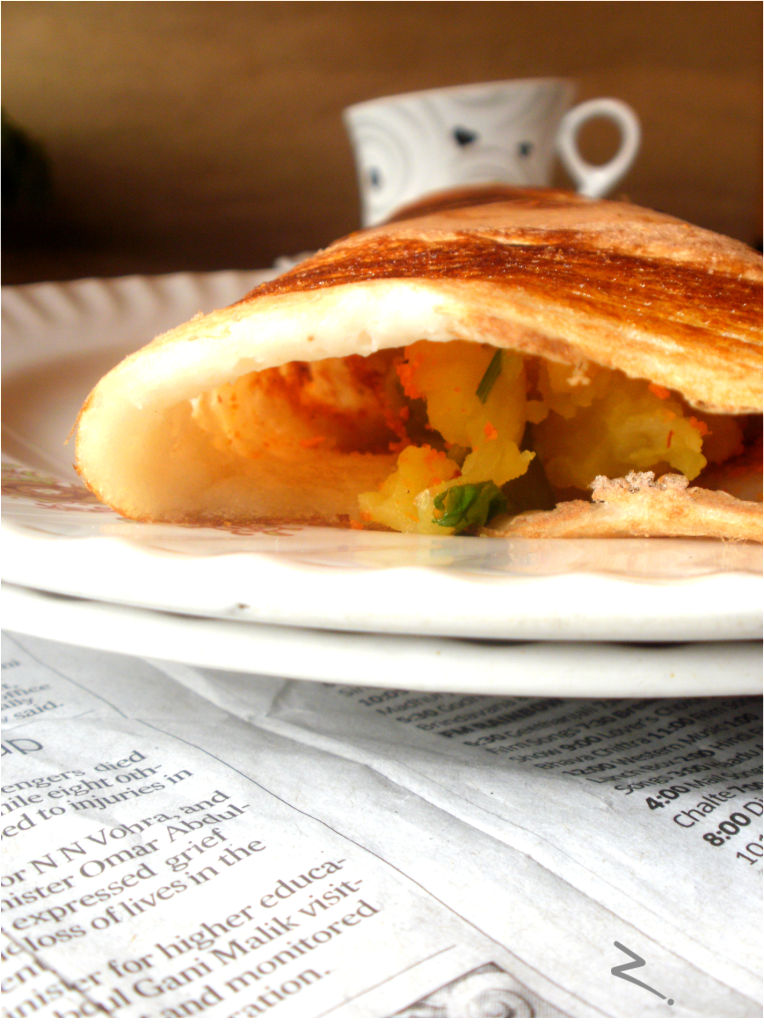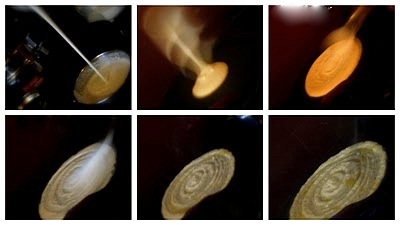
Coming now to the popular South Indian breakfast – Masala Dosa. No South Indian restaurant exist which does not have Dosa on the menu! Dosas are made from fermented rice and lentil batter and cooked similar to crepes. Dosas can be either thin and crisp or soft and bit thicker. No doubt preparation of the batter takes few hours as the ingredients need to be soaked & then after grinding the batter again needs to be fermented.
These dosas are a staple dish to South Indians just as the roti for the North Indians. And hence they find their way to the breakfast table in a South Indian home practically everyday!!
To me the art of making a dosa is just that..an art which I have yet to master. Few attempts were underway and then after I had to eat my own creation, I decided on enjoying what my Amma makes for the time being.
But do make and taste it once and you will definitely want to make it a regular in your homes. Here the quantity and measurements need to be precise. The rice and split black gram (urad dal) needs to be soaked for few hours and then ground to form a thick and smooth batter. The batter is then left to ferment in warm conditions and once they turn sour (about 6 to 8 hours) they are ready to be turned into crisp and soft mouthwatering dosas!
Crisp masala dosa!
~ The fermentation process increases Vitamin B and Vitamin C content.
Coming up next is the recipe for red chutney to make the classic Masala dosa complete!
Click here for Potato bhaji recipe
Click here for coconut chutney recipe
Dosa/ Masala Dosa
Popular South Indian breakfast!
Basic dosa batter
- pav = traditional measure, 1 pav equals 1.5 cups
- Dosa rice – 4 pav (raw rice/short grained)
- Urad dal (skinned – 1 pav)
- Fenugreek (methi seeds – 2 tbsp)
- Thin poha – 2 fistfuls
- salt – to taste
- Water – as needed to grind batter
- Ghee/oil – as needed to roast dosas
Equipment Needed
- A wet grinder (preferably or a mixer)
- A griddle/tawa or an iron pan
- A big steel ladle (deep round)
- A steel spatula
To start with
- You could start with the washing and soaking process in the morning and grind them to batter late evening, leave to ferment overnight and you have the batter ready to make dosas next morning! You could soak the dal and rice overnight too, grind next morning and let the batter ferment till ready (4 to 5 hours or more).
Preparing the batter
- Wash both varieties of rice and the dal. Drain.
- Soak the rice, urad dal and methi seeds for 4 to 5 hours.
- Drain, wash and grind the rice and the dal together in a wet grinder till you get a smooth and a semi thick batter/ fluffy and light medium pouring consistency batter. Add water as required for grinding. Do not add lot of water all together but add a little at a time. You would need about 3/4 cup or more water.
- Then wash the thin poha under running water, squeeze out the water and add to the batter and grind again for about 5 minutes till smooth again.
- Transfer the batter to a large container as the fermented batter will increase in volume. Leave to ferment till frothy in a warm place overnight or for 8 to 10 hours. When fermented you will see bubbles on top.
To make dosas
- heat the pan/griddle over medium heat till the pan sizzles when few drops of water are sprinkled on it. Then spread a tsp of ghee/ oil evenly over the pan. Do not add too much as the batter will not spread evenly.
- Add little water to batter if its too thick. Spoon a big ladle of batter onto the center of the pan (with the flame at medium and NOT low) and using the back of the ladle quickly spread the batter using circular motion. The batter should not be too thick.
- Lace the sides of the dosas with some oil/ ghee and roast till the underside turns golden and is slightly crisp and does not stick to the pan, about 1 to 2 mins.
- Flip and cook the other sides for few seconds only, drizzling ghee/oil if needed. Flipping is optional, but make sure the top side is not raw and the dosa is cooked well from inside. Flip back, remove and serve hot.
- Sprinkle water on the pan and wipe once so that it does not get overheated.Repeat making dosas for remaining batter. Repeat the sprinkling water-wiping-oiling process after each dosa.
For Masala Dosa
- Roast both sides, before you remove dosa from pan, sprinkle chutney powder or some red chutney on top. Keep potato bhaji in center. Fold over from both sides, remove and serve hot.
- Serve hot with Coconut Chutney.
If the weather is quite warm all through the year, once the batter is ground may transfer amount required for the next day onto a separate container and leave to ferment at room temperature. The remaining batter should be transferred to another container and refrigerated to be used for later days.
You could also add salt to the amount of batter needed for next day after grinding itself and leave it to ferment overnight during winters or in case you want to speed up the fermentation process. Keep any remaining batter in the fridge without adding salt to be used on second or third day, else the batter will too sour.
Salt is added just before making the dosa. Adding salt early will make the batter too sour to be used for later days.
The batter lasts for about 4 to 5 days.
The quantities of rice, dal, methi and poha can be reduced proportionately to suit your requirements.
The methi/ fenugreek seeds are added as it gives a nice brown color and flavor to dosas.
Adding beaten rice/ poha is purely optional. They are added to make dosas softer.
During winters or in colder regions, you could leave the batter to ferment inside an oven that has been preheated and turned off.
You could also make from the batter from 3 pav parboiled/ sela rice plus 1 pav dosa rice also in place of 4 pav of only dosa rice. Rest of the ingredients will be the same.
To the basic dosa batter you may also add some chopped onions, cilantro, green chillies to make onion uttappam.
For cheese dosa :
You could also sprinkle some grated cheese on the white side of the dosa once cooked on both sides and then remove from the pan and serve immediately with coconut chutney.




Comments are closed.